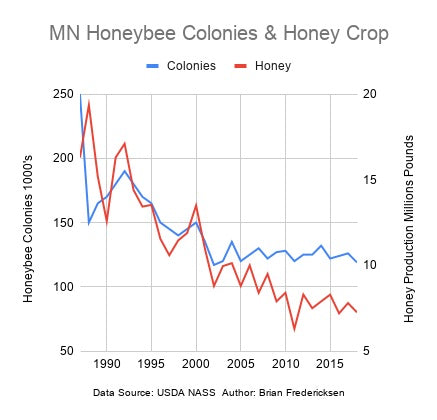Land For Bees Mission

Over my lifetime as a beekeeper and avid nature lover, I have witnessed the loss of pollinator numbers firsthand. As a child growing up in the 1960's my grandmother Verna took me on numerous day trips. We would observe a dozen or more different species of butterflies and native bees in a day. Finding idle land full of flowers for pollinators was taken for granted.
The summer of 2006 was the last time I remember seeing the sky full of native pollinators and my honeybees fighting over the last nectar of the season in a 160 acre field of buckwheat near the Iowa border.
Now I can drive a whole day on the back roads of Minnesota and keep track of the remaining few species of butterflies, moths and bumble bees I see.
While there are many reasons for the change in pollinator numbers, the loss of habitat in the form of trees, shrubs and plants is a leading reason. It’s also something most people can do something about especially landowners.
Land For Bees - The Vision
I want to raise awareness about the lost habitat and leave my land set aside in conservation easements with the primary use as pollinator refuges.
Ideally I would convince the state of MN to create a campaign to encourage rural landowners to plant some of their land for bees and pollinators. When I grew up everyone had heard of Smoky the Bear and knew they should be careful with fires etc. Why not create a similar message and promote it as good land stewardship?
I thought the obvious place to start this initiative is to replant my own land as an example.
So to separate the farm business from the land, Land For Bees was formed as a land holding company and now owns 233 acres. Some of the land is rented to Ames Farm and an apartment generates rental income. The three properties are:
40 acres of land that Ames Farm uses as its main honey farm in central Minnesota near Watertown. About 80% of the land is not tillable and is a mix of wetlands, woods and prairie. The land is home for the main honey processing building and bee shed along with 2 apple orchards.
33 acres in East Texas of mostly meadows with a pond and some woods. There is a house and some farm buildings. Ames farm uses the property as a winter bee farm and maintains a small herd of goats to help maintain the meadows.
160 acres in the far north eastern tip of the Arrowhead of Minnesota a few miles from Canada. The land is basically wilderness and has 3/4 mile driveway to a log cabin and features a large beaver pond, old birch and white pine trees.
The idea is to build up perpetual revenue streams from these properties so that regardless of what happens to Ames Farm, the properties can generate income and be maintained as pollinator refuges indefinitely.
Support Our Mission
Help us rewild and maintain 233 acres of land for pollinators. Replanting trees and flowers for pollinators is a major emphasis that these funds will be used for along with annual mowing and weed management. Additional one time costs are anticipated for land conservation easements and legacy planning.
Return to Land For Bees Main Page
